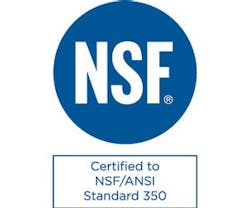NSF Releases First U.S. Water Reuse Standard
Addressing the increasing popularity of water recycling, NSF International recently premiered Standard 350, a first-of-its-kind standard that addresses on-site treatment for wastewater reused for applications beyond subsurface irrigation.
The organization has also introduced 350-1, which focuses specifically on graywater for subsurface discharge.
“Subsurface discharge into the soil is very typical of water reuse systems,” says Tom Bruursema, water reuse expert and general manager of NSF’s sustainability division. “Standard 350 covers non-drinking water applications, such as surface irrigation, toilet and urinal flushing, and potentially car washing. It’s focused on the treatment technology.”
The Standard 350 logo appearing on NSF-certified products verifies that treatment systems meet the organization’s design, performance, and quality standards. Requirements include sufficient alarm systems, piping clearly labeled as containing reuse water, easy access for maintenance, maximum noise levels, and other issues affecting the operation, as well as a comprehensive treatment system that ensures acceptable levels of quality indicators like turbidity, microorganisms, and suspended solids.
The standard is likely to gain favor first in states where water is a precious and expensive commodity, but the environmental benefits of such a system and its ability to fulfill LEED requirements will help the technology gain popularity, Bruursema says.
“Users will have the immediate reduction in consumption of potable water. If they use the public water supply, there will be cost savings in terms of their water bills,” Bruursema explains. “In the long term, the reduction in the use of potable water has an environmental benefit and reduces the amount of energy consumed to transport potable water and wastewater to a facility for treatment.”
